
2.1 Household estimates methodology
Household estimates for Scotland are produced annually, based on data from local authority Council Tax records. Households are considered to be those occupied dwellings for which Council Tax is paid, or which are occupied but exempt from Council Tax. They exclude dwellings which are vacant or second homes.
Extracts of the Council Tax databases are taken at September each year. The number of occupied dwellings is then adjusted to 30 June to produce mid-year estimates that correspond to the mid-year population estimates. They are adjusted by taking different proportions of the Council Tax data from the relevant years[3].
In order to improve comparability between data sources, and because the census is the most reliable source of household estimates available, the Council Tax data for each local authority in each year is adjusted to take account of the differences between it and the census estimates in each census year. Prior to the release of the 2011 Census, the household estimates for each year were adjusted by the difference between the number of households recorded in the 2001 Census and the 2001 Council Tax figures (this includes the publication 'Estimates of Households and Dwellings in Scotland, 2011' on the NRS website). This was done by producing a census-based estimate for June 2001 using a methodology similar to that of the household projections[4] and calculating the difference in the number of households between this estimate and the household estimate from the Council Tax data. This difference was then added to each subsequent year's household estimate.
In the latest publication (Estimates of Households and Dwellings in Scotland, 2012 available on the NRS website), the adjustments are updated to incorporate 2011 Census information. The 2001 and 2011 estimates are adjusted by the percentage difference between the number of households recorded in the relevant census (adjusted to June), and the Council Tax data for that year. The census estimates are adjusted to June by adding the relevant proportion of the change in the unadjusted household estimates between 2001 and 2002, or 2011 and 2012, respectively. The adjustments to the household estimates from 2002 to 2010 incorporate both the 2001 and 2011 Census estimates (adjusted to June) by taking a part of the percentage adjustment from the 2001 year and a part from the 2011 year.
In this section, several datasets are compared, each giving an estimate of the number of households for 2011, and an estimate of the change in the number of households between 2001 and 2011. These datasets are described below, and at Table A. The data sets are:
Two sets of comparisons are presented below. Firstly, 2011 Census estimates are compared to the 2011-adjusted household estimates. This comparison shows the estimated effect of the household estimate referring to a date three months later than the census (June rather than March).
The second set of comparisons compares the unadjusted and the 2001-adjusted household estimates to the 2011 Census and the 2011-adjusted household estimates. These comparisons are used to assess the performance of the methodology used for the household estimates up to 2011 and in particular whether the adjustment to the 2001 Census improved the quality of the household estimates.
2.2 Comparison of household numbers
Scotland
The 2011 Census estimate of the number of households in Scotland, at March 2011, is 2,372,780. The 2011-adjusted household estimate, at June 2011, is 2,375,430.
In comparison, the unadjusted household estimate is 2,391,022:
The 2001-adjusted household estimate is 2,368,034 households:
A quick reference guide to the origins of the different estimates can be found at Table A.
The 2001-adjusted estimate is closer to both the census estimate and the 2011-adjusted estimate than the unadjusted estimate. This suggests that, during the period when the 2001 Census estimate was the most recent census data available, using it to adjust the household estimates for Scotland improved the quality of the household estimate for Scotland.
Local Authorities
Table 1 compares the same four sets of numbers for 2011. The 2011-adjusted household estimate for each local authority varies from a difference of less than 0.05 per cent in seven local authorities (Aberdeen City, Clackmannanshire, Glasgow City, Inverclyde, North Ayrshire, Renfrewshire and West Dunbartonshire) to being 0.4 per cent above the census estimate in Eilean Siar. It is not surprising that these differences are fairly small as the 2011-adjusted household estimate incorporates 2011 Census estimate, meaning that these differences represent the change in household number over just three months.
The unadjusted household estimates for local authorities were between:
The majority of local authorities were within one per cent of both the census estimate (19 local authorities) and the 2011-adjusted household estimate (21 local authorities). The difference between the unadjusted household estimate and the census estimate for each local authority can be seen in Figure 1.
Figure 1: Difference between the unadjusted household estimate and the Census estimate, 2011

In comparison, 2001-adjusted household estimates for local authorities were between:
Again, the majority of the local authorities were within one per cent of both the census estimate and the 2011-adjusted household estimate (19 in both cases). The difference between the 2001-adjusted household estimates and the census estimates can be seen in Figure 2.
Figure 2: Difference between the 2001-adjusted household estimate and the Census estimate, 2011
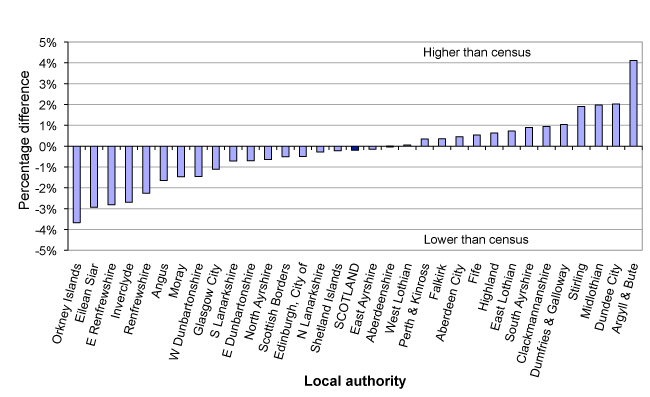
In the year that the census is collected there is a clear benefit of adjusting the Council Tax derived estimates to take account of the census estimate, to reduce any large discrepancies between the household estimates and the census estimates. The figures above, however, indicate that the benefit of adjusting the household estimates to the previous census is less clear-cut by the time a decade has passed since that census. Compared to the unadjusted household estimate, including the adjustment to the 2001 Census increased the range of the differences between the household estimate and both the census estimates and the 2011-adjusted household estimates. However, it meant that a local authority was almost as likely to be above the 2011 Census estimate as below, which was not the case in the unadjusted household estimates. In the unadjusted household estimates seven local authorities were found to be below the census estimate, and the rest above, whereas in the 2001-adjusted household estimate 17 local authorities were below the census estimate and 15 above. For Scotland as a whole, both figures differ from the 2011 Census estimate by less than one per cent, but the 2001-adjusted household estimate was closer than the unadjusted household estimate (-0.2 per cent vs +0.8 per cent).
Simply looking at the range of differences from the census and 2011-adjusted household estimates can disguise the effects on individual local authorities. In Figure 3 the size of difference between the 2001-adjusted household estimate and the 2011 Census estimate (Table 1, column 6) has been subtracted from the size of the difference between the unadjusted household estimate and the 2011 Census estimate (Table 1 column 7), for each authority. This gives a measure of whether the 2001-adjusted estimate or the unadjusted estimate was closer to the Census. Where the resulting difference is a positive number the 2001-adjusted household estimate was closer to the census estimate than the unadjusted estimate and where the difference is a negative number the reverse is true. The size of the bar shows the scale of the difference for each local authority.
Figure 3: Comparison of the differences between the unadjusted and 2001-adjusted household estimates and the 2011 Census
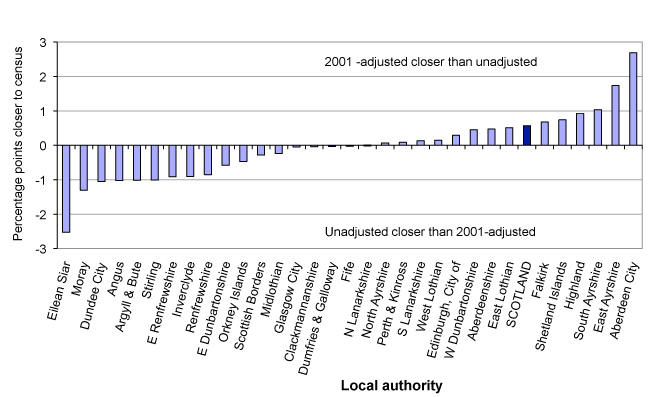
The 2001-adjusted household estimate was closer to the census estimate than the unadjusted household estimate in 14 local authorities and very similar (within 0.05 percentage points) in a further five. Again, this suggests that adjusting to the census estimates does not significantly improve the estimates a decade after the census. On the other hand, including the adjustment does not introduce major errors, as the unadjusted household estimate is only more than one percentage point better than the 2001-adjusted household estimates in three local authorities. In the authorities where the 2001-adjusted estimate for 2011 is further away from the census estimate than the unadjusted estimate it is possible that it has been affected by undercounting or overcounting of households in that authority in the 2001 Census, rather than differences between the Council Tax and Census data. Including the adjustment still improves the household estimate at the Scotland level, as the 2001-adjusted estimate for Scotland is 0.6 percentage points closer to the census estimate than the unadjusted household estimate.
Conclusion
Estimates of the number of households in Scotland and its local authorities, using the households estimates methodology, are highly consistent with the numbers estimated in the 2011 Census. The 2001-adjusted household estimate, published prior to the release of 2011 Census, was within one per cent of the 2011 Census estimate both for Scotland as a whole, and for the majority of its local authorities. Fundamentally, the household estimates and the census come from different data sources, each with inherent levels of uncertainty in the underlying data, therefore the numbers would not be expected to be identical[5]. Both the census and the Council-Tax based methodologies aim to estimate the true number of households in Scotland. The fact that the two estimates are close to each other suggests that both the 2001-adjusted household estimates, based on Council Tax data, and the 2011 Census produce close estimates of the true number of households in Scotland.
There are several possible explanations for any differences between the census estimates and the Council Tax-based estimates. Discussed above are three reasons for differences between the 2011 figures; (1) that the estimates refer to different dates, (2) that the 2001 Census adjustments made to the household estimates published prior to the release of the 2011 Census are based on data that by 2011 was a decade old, and (3) that there may have been undercounting or overcounting in individual local authorities in the 2001 Census. Other causes of difference between the census estimates and the Council Tax-based estimates are thought to be that:
Part of the household estimates methodology adjusts the estimate to take into account the difference between the census and Council Tax data in the year of the latest census. This is done because the census is designed to count households, whereas an administrative data source, such as the Council Tax data, is not designed specifically to count households. The household estimates based on Council Tax data therefore use occupied dwellings as a proxy measure of households. Adjusting the household estimates to take into account the census helps to take account of any differences between the definitions of household and occupied dwellings described above.
The adjustment of the household estimates to the census is clearly beneficial in the initial year of adjustment, however by the time the census estimate is a decade old the adjustment, while still improving the quality of the data for Scotland as a whole, may or may not benefit individual local authorities. This is to be expected as the factors influencing the difference between the household estimate and the census estimate may have changed between 2001 and 2011. The method for the adjustment has been modified slightly following the release of the 2011 Census and it will be important to continue to monitor the benefit of the adjustment.
2.3 Comparison of the change in household numbers between 2001 and 2011
An alternative comparison between the census and the household estimates is to compare the change in each dataset between 2001 and 2011. Table 2 presents these figures.
A quick reference guide to the origins of the different estimates can be found at Table A.
Scotland
According to the 2011 Census there were 180,530 more households in Scotland in 2011 than in 2001, an 8.2 per cent increase. The 2011-adjusted household estimates show a increase of 179,723 households (8.2 per cent) between 2001 and 2011. This change is very close to the change between the censuses because, in the 2011-adjusted household estimates, the 2001 estimate is adjusted to the 2001 Census and the 2011 estimate is adjusted to the 2011 Census.
According to the 2001-adjusted household estimates there were 173,001 more households in 2011 than in 2001, an increase of 7.9 per cent. The 2001-adjusted household estimates are adjusted by the same number of households in 2001 and 2011 therefore the change in the number of households is identical in the unadjusted and 2001-adjusted estimates.
Local Authorities
The changes in household number between 2001 and 2011, from census estimates, range from a 2.0 per cent increase in Inverclyde, to a 15.4 per cent increase in Aberdeenshire and a 16.6 per cent increase in the Orkney Islands. In the 2011-adjusted household estimates the changes in household number vary from a 1.9 per cent increase in Inverclyde, to a 15.5 per cent increase in Aberdeenshire and a 16.7 per cent increase in the Orkney Islands. As with Scotland, the changes seen in the 2011-adjusted household estimates are close to those seen on census day.
Figure 4 shows the difference in the 2001 to 2011 change in household numbers between the Census and the 2011-adjusted household estimates. The differences in the percentage change between 2001 and 2011 are small, ranging from 0.2 percentage points lower in West Lothian to 0.3 percentage points higher in Eilean Siar.
The changes in the number of households between 2001 and 2011 in the 2001-adjusted household estimates range from a 0.7 per cent decrease in Inverclyde to a 14.6 per cent increase in Highland and a 15.2 per cent increase in Aberdeenshire. Like Scotland, the changes in number in the unadjusted and 2001-adjusted household estimates are the same for all local authorities.
Figure 5 shows the difference in the 2001 to 2011 change in household numbers between the census and the 2001-adjusted household estimates. The differences between the percentage change between 2001 and 2011 range from 4.3 percentage points lower in the Orkney Islands to 4.0 percentage points higher in Argyll and Bute. The difference in the percentage change from 2001 to 2011 between the 2001-adjusted household estimate and the Census is less than one percentage point for the majority of the local authorities (19).
Figure 4: Difference in the 2001 to 2011 percentage change in household numbers between the Census and the 2011-adjusted household estimates
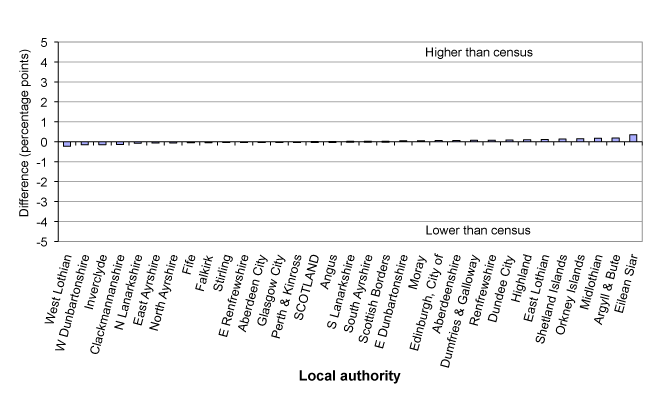
Figure 5: Difference in the 2001 to 2011 percentage change in household numbers between the Census and the 2001-adjusted household estimates
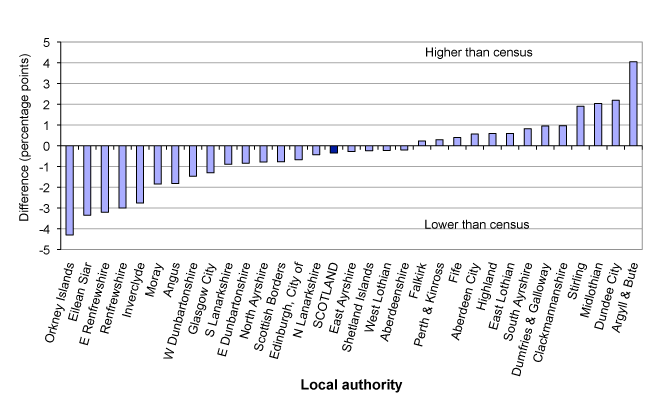
Conclusion
The performance of the household estimates methodology in estimating the change in the number of households between 2001 and 2011, in Scotland and its local authorities, as compared to the 2011 Census, is good. The change in the 2001-adjusted household estimates, published prior to the release of 2011 Census, was within one percentage point of the change between the 2001 and 2011 Census estimates both for Scotland as a whole, and for the majority of its local authorities.
The publication of the 2011-adjusted household estimates, incorporating 2011 Census data, brings the 2001 to 2011 change much closer to that between the 2001 and 2011 Censuses, with the change being within 0.4 percentage points of the census estimate in all local authorities.
The factors contributing to the differences in household numbers between the household estimates and census estimates, described in Section 2.2, are also those that impact on the change in household numbers described in this section.
2.4 Comparison of average household size
Average household size is calculated using the household estimates, the mid-year population estimates[6], and communal establishment rates from the 2001 and 2011 Censuses. The first step in calculating average household size is to calculate the number of people living in private households ('private household population') rather than in communal establishments, such as student halls of residence, prisons or care homes. This is done by applying the communal establishment rates to the mid-year population estimates to estimate the communal establishment population, and subtracting these people from the mid-year population estimate. Communal establishment rates for 2002 to 2010 were estimated from the 2001 and 2011 Census rates. The second step was to estimate average household size by dividing the private household population by the household estimate. Average household size was included in the 'Estimates of Households and Dwellings in Scotland' for the first time for 2012.
Scotland
According to the 2011 Census, the average household size in Scotland in 2011 was 2.19 people per household, a decrease from 2.27 people per household in 2001. In the 2011-adjusted household estimates, average household size in 2011 is 2.17 people per household, a decrease from 2.27 people per household in 2001. The difference in average household size between the census and the 2011-adjusted household estimates in 2011 is just 0.02 people per household.
Local Authorities
Table 3 compares average household size in 2001 and 2011 between the census and the 2011-adjusted household estimates for each local authority. According to the 2011 Census, average household size ranged from 2.02 people per household in Glasgow City to 2.42 people per household in East Renfrewshire. The census reports decreases in average household size between 2001 and 2011 in all local authorities, with the largest decrease seen in Eilean Siar (-0.15 people per household) and the smallest in Falkirk (-0.05 people per household). In the 2011-adjusted household estimates, average household size ranged from between 2.03 people per household in Dundee City to 2.40 in East Renfrewshire. The 2011-adjusted household estimates report decreases in average household size in almost all authorities, with the largest decrease seen in Eilean Siar (-0.28 people per household). The only exception to this is in the City of Edinburgh where the 2011-adjusted household estimates show an increase in average household size of 0.01 people per household between 2001 and 2011.
Figure 6 shows the difference in average household size between the census and the 2011-adjusted household estimates in 2011. The differences range from that of Moray, where the average household size from the 2011-adjusted household estimate is 0.15 people per household lower than the 2011 Census, to the City of Edinburgh where the average household size from the household estimate is 0.08 people per household more than the 2011 Census. In 2011 almost all average household sizes were within 0.1 people per household of the census estimate.
Figure 6: Difference in average household size between the 2011-adjusted household estimates and the Census, 2011, by local authority
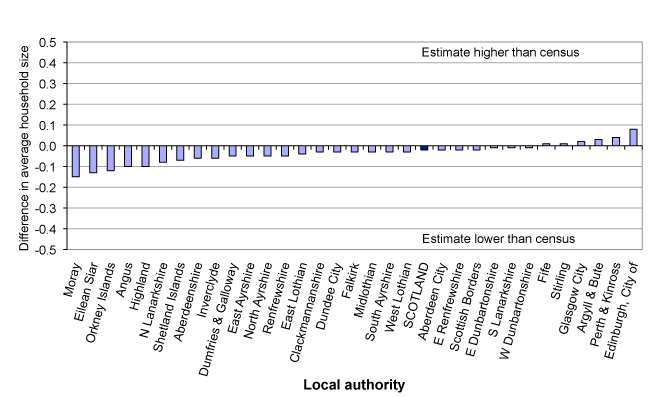
Conclusion
The 2011 average household sizes, from the 2011-adjusted household estimates, were close to the average household sizes estimated in the 2011 Census, although for the majority of local authorities the average household size from the household estimates was lower than that from the 2011 Census. While the differences between the household estimates from the data sources described earlier will have affected the average household size, much of the difference in average household size is likely to be driven by differences between the mid-year population estimates and the population estimates from the census, as the mid-year population estimates have not yet been revised to take into account the 2011 Census[7]. As the population estimate from the census was above the mid-year population estimate for 2011, it is likely that estimates of average household size based on the mid-year estimates would be higher, and therefore closer to the census estimates, if the mid-year population estimates took into account the 2011 Census.